Introduction
Tour
{{section_header}}{{section.name}}{{/section_header}}




Ease of Use
{{section_header}}{{section.name}}{{/section_header}}
Despite its plethora of controls, the P7000 remains quite easy to use, with a standard menu and a unique quick menu dial. This dial gives instant access to six features that Nikon has deemed particularly handy. The dial gives easy access to ISO, quality settings, white balance, bracketing, tone level information, and "My Menu." The latter option is a customizable menu, where you can select your most commonly used features.
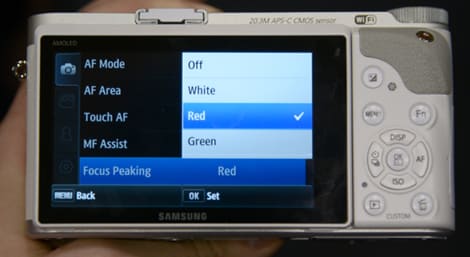
There's also a dedicated exposure compensation dial, mode dial, and a handful of other buttons. The buttons on the back are likely to cause the most consternation to beginners, as few of them are labeled and it takes an experienced photographer to recognize all the functions.

Size & Handling
{{section_header}}{{section.name}}{{/section_header}}
The Nikon Coolpix P7000 is larger than most pocket cams, which you would come to expect from a high-end point-and-shoot. The dimensions are 4.5 in. x 3.1 in. x 1.8 in, making it small enough to fit comfortably in a purse or large coat pocket, but not small enough to slip into a dress shirt pocket. It weighs 12.7 oz., which is less than ultrazoom cameras from Nikon, but considerably more than the rest of the Coolpix lineup.
The P7000 is comfortable to hold, with its textured grip on the front for your right hand and buttons that are (for the most part) within easy reach.
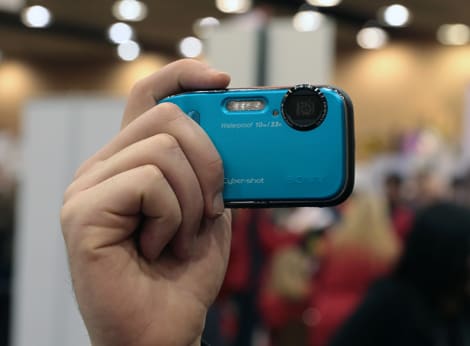
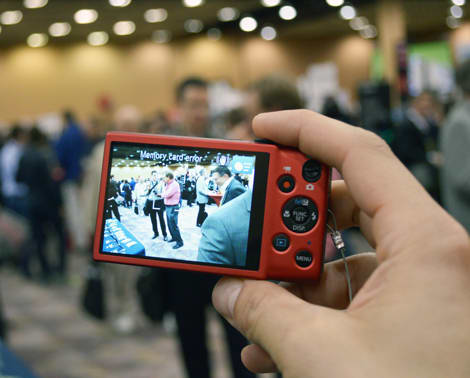
Auto Mode
{{section_header}}{{section.name}}{{/section_header}}
The most basic of the P7000's auto modes is Scene Auto Selector, which automatically chooses one of the camera's scene modes based on the subject being filmed. There is also a regular Program mode, which will automatically adjust aperture and shutter speed, but maintain the user's ability to adjust ISO, exposure compensation, etc.
For those looking for a true cruise control experience, the entire Coolpix series carries a number of automated tools: skin softening, Face-Priority AF, Smile mode, subject tracking, and in-camera red-eye correction.
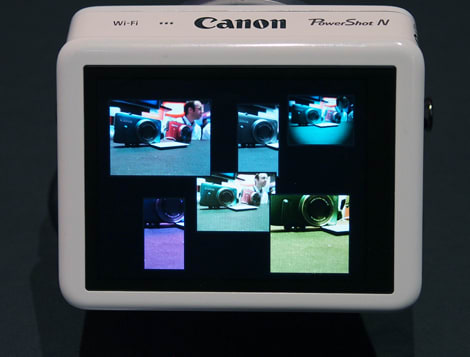
Movie Mode
{{section_header}}{{section.name}}{{/section_header}}
The Nikon D7000 is capable of recording 720/24p HD video with stereo sound. You can use the built-in microphone, but the P7000 also supports powered external microphones.
Custom Image Presets
Drive/Burst Mode
{{section_header}}{{section.name}}{{/section_header}}
The P7000 has all the usual burst and drive modes, but of particular interest is the continuous shooting mode, which is available in JPEG as well as RAW. This is an unusual amount of versatility for a point-and-shoot camera.
Manual Controls
{{section_header}}{{section.name}}{{/section_header}}
Manual controls abound on the Coolpix P7000, offering more versatility than we've seen on just about any point-and-shoot camera. There's a full manual mode, as well as aperture priority and shutter priority. We were especially excited to see the ISO, white balance, and shutter bracketing—all unusual features for any camera. Exposure compensation has a dedicated dial, while aperture and shutter speed can be set as usual, using the dial on the back of the camera. An easy menu dial gives you quick access to some of the camera's more useful functions, like ISO and bracketing.

Focus
{{section_header}}{{section.name}}{{/section_header}}
The focus range of the P7000 is 50cm to infinity, though you can shoot closer subjects by switching to macro (2cm to infinity).
ISO
{{section_header}}{{section.name}}{{/section_header}}
The P7000 has a deep selection of ISO options. As might be expected, you can select an ISO level manually, choosing from among seven different levels: ISO 100, 200, 400, 800, 1600, 3200, and Hi 1. That last option is full resolution extended range option, with an equivalency of ISO 6400. An even further expanded ISO range is available in low noise night mode (ISO 400-12800), but only at a reduced resolution of 3MP or less.
Should you choose to allow the camera to select ISO automatically, you have some control over limiting the gain. Regular auto will select an ISO from 100 to 800. Alternately, you can select a fixed auto range of ISO 100-200 or ISO 100-400.
The P7000 also offer the unique AE(Sv) bracketing option, which shoots a consecutive series of shots at a variety of ISO settings.
Aperture & Shutter Speed
{{section_header}}{{section.name}}{{/section_header}}
Aperture and shutter speed can both be adjusted while in full manual mode or in their respective priority modes. The P7000 offers an unusual shutter speed bracketing option.
White Balance
{{section_header}}{{section.name}}{{/section_header}}
The P7000 has a modest selection of white balance presets, as well as the ability to set a manual white balance. The camera also offers white balance bracketing.
Exposure & Metering
{{section_header}}{{section.name}}{{/section_header}}
Exposure compensation is available in the standard range of +/-2 EV in 1/3-stop increments. Users can adjust exposure compensation using a dedicated dial on the top of the camera.
Image Stabilization
{{section_header}}{{section.name}}{{/section_header}}
The Coolpix P7000 features optical lens shift VR image stabilization. In additional to this standard optical stabilization, the P7000 has a "motion detection" feature, which can automatically select a faster shutter speed and higher ISO in order to compensate for a moving subject or camera shake.
Picture Quality & Size Options
{{section_header}}{{section.name}}{{/section_header}}
Nikon has included in the P7000 and option to use the company's NRW (RAW) file format. This Nikon version of RAW is compatible with features that often do not function when shooting in RAW, including continuous shooting and D-Lighting.
Other Controls
{{section_header}}{{section.name}}{{/section_header}}
Custom User Settings
This is one of the more versatile point-and-shoot cameras that we've seen, with three customizable user settings accessible via the mode dial on the top of the camera. You can program focal length and other image controls for each setting and save them for future use.
Zoom Memory
The P7000 lets select between seven preset focal lengths, mimicking the effect of switching between seven different lenses. The 35mm equivalents of the focal length presets are: 28mm, 35mm, 50mm, 85mm, 105mm, 135mm, and 200mm.
Tone Level Information
This handy tool displays tone levels for any point within the framed image. What makes the feature truly worthwhile is the ability to make fine adjustments to exposure compensation, aperture, shutter speed, or ISO from within the tool.
Noise Reduction Adjustment
Adding to the already deep selection of manual controls, Nikon allows the user to select "Low" noise reduction in order to place more importance on the sharpness of fine detail. This isn't "no" noise reduction, but it's clearly better than having no control at all.
LCD & Viewfinder
{{section_header}}{{section.name}}{{/section_header}}
Like most Coolpix cameras, the P7000 sports a 3.0-inch TFT LCD with anti-reflection coating. The P7000 received Nikon's higher resolution LCD, with a total pixel count of 921,000.

If you'd like the added insurance of an optical viewfinder, the P7000 has that too—complete with diopter adjustment.

Flash
{{section_header}}{{section.name}}{{/section_header}}
The P7000 has a built-in flash, with many of the options you'll find on most cameras, including standard red-eye reduction.

Lens & Sensor
{{section_header}}{{section.name}}{{/section_header}}
The P7000 is equipped with a Nikkor wide-angle 7.1x optical zoom lens. The focal range is 6.0–42.6mm (35mm equivalent: 28–200mm), which is quite impressive for a point-and-shoot camera. The aperture range is f/2.8–5.6. The lens also boasts a built-in ND (neutral density) filter. If you're unsatisfied with the 7.1x optical zoom, a 4x digital zoom is there to back you up.
The 1/1.7 in. CCD sensor has an effective pixel count of 10.1MP. The sensor is paired with Nikon's EXPEED C2 Image Processing Engine, which is designed to maximize "achievable levels of high resolution, fine detail, and high image quality." (Aren't they all?)

Jacks, Ports & Plugs
{{section_header}}{{section.name}}{{/section_header}}
The P7000 has a small port cavity, with a miniHDMI output and a proprietary connection for USB/AV.
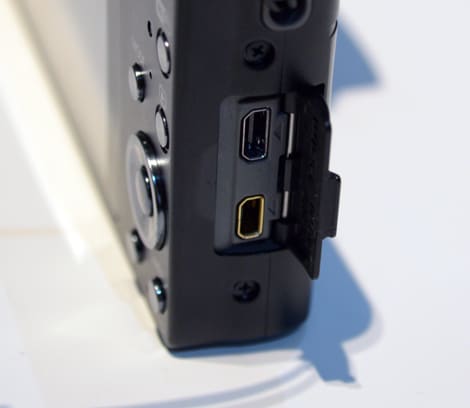
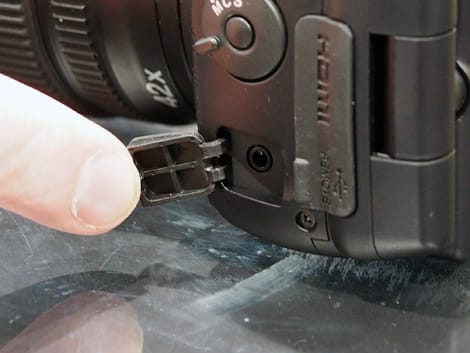
Battery
{{section_header}}{{section.name}}{{/section_header}}
The Coolpix P7000 is powered by a rechargeable lithium-ion battery (EN-EL14). The camera ships with a separate charger for the battery. You can purchase an AC adapter separately, if you'd prefer to charge the battery in-camera. According to the specifications from Nikon, the EN-EL14 is rated for approximately 350 photos.

Memory
{{section_header}}{{section.name}}{{/section_header}}
The primary recording media for the P7000 is SD/SDHC/SDXC memory cards. We were glad to see that the P7000 supports SDXC, since many of the lower-end Coolpix cameras do not. If you want to shoot right out of the box or need a little backup space for when memory cards are filled, the P7000 has a modest amount of internal flash memory (79MB).
{{product.manufacturer_specs['FI Memory Photo']}}
Other Hardware
{{section_header}}{{section.name}}{{/section_header}}
Virtual Horizon
This is essentially an electronic level, which will help you determine whether the camera is even with the horizontal plane.
Conclusion
The Nikon P7000 looks to be an exciting camera for advanced users, with tons of manual controls that go above and beyond the usual offerings for a point-and-shoot camera. It doesn't have as many dedicated controls as the Canon G12 (or the newly announced Fujifilm X100), but the quick menu dial sets it apart from much of the competition. Fans of Nikon will be especially excited—especially if the camera's performance lives up to expectations.
Sample Photos
{{section_header}}{{section.name}}{{/section_header}}
Specs
{{manufacturer_specs_table}}
Meet the tester
Vice President of Editorial Management, Kaitlyn oversees the editorial departments of Reviewed.com’s various sites. She has been writing about technology since the turn of the century. Outside of her Reviewed.com home, Kaitlyn is also a theatre director and avid gamer.
Checking our work.
Our team is here to help you buy the best stuff and love what you own. Our writers, editors, and experts obsess over the products we cover to make sure you're confident and satisfied. Have a different opinion about something we recommend? Email us and we'll compare notes.
Shoot us an email